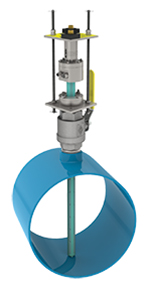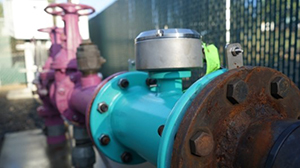Whether decision-makers consider it ultimately attainable or not, there is something positive to be said about striving toward ‘net zero leakage’ in water distribution systems saddled with high non-revenue-water (NRW) losses. The key is taking affordable steps – like those described below – toward identifying and mitigating the most egregious water loss locations in a distribution system, based on readily accessible data.
The key is taking affordable steps – like those described below – toward identifying and mitigating the most egregious water loss locations in a distribution system, based on readily accessible data.
Take stock of the situation
Water loss that is not monitored cannot be measured. And if it is not measured, it cannot be managed efficiently. But don’t let ‘perfection become the enemy of good’. With increased concerns about water scarcity and the cost of water, and with affordable monitoring options that can be employed selectively, now is a good time to focus on water leak data collection that can have both immediate and long-term benefits. Look for incremental steps that can help utilise limited resources more efficiently and whittle down NRW loss rates on the way toward net zero leakage.

The concept of reducing water losses has been advocated by the International Water Association for some time, and various water distribution companies in Europe have already taken steps toward monitoring it. But much of the US and the rest of the world still has plenty of potential for addressing the interrelated issues of water scarcity, revenue loss, and capital budgets through better control over NRW losses attributed to leaks. Having the data to quantify an economic level of leakage (ELL) enables utilities to make more informed decisions on water losses and leak repairs, even if the ELL changes.
One of the biggest barriers in the migration toward net zero leakage is a lack of urgency driven by fears that the solution can be more costly than the problem. Perhaps that is a reason why the most recent Ofwat Report of the development of the water industry in England & Wales cites ageing infrastructure as the huge concern yet ranks water loss as a far less significant problem.
As with so many other managerial decisions in utility operations, the key comes down to the affordable collection of appropriate data.
Divide and conquer – identifying biggest problems, quickest solutions first
The first steps toward minimising water loss are knowing:
a.) that water is being lost,
b.) how much of it is being lost, and
c.) where it is being lost.
Monitoring water inputs vs. water consumption on an area-by-area basis is an effective way to identify the most problematic areas where informed repair vs. replace decisions can result in the most financially viable water and cost savings. Gathering key distribution system operating data through appropriate smart water and IoT investments in flow monitoring, pressure logging, and data management systems can provide the insights needed to lower water losses incrementally, step by step, en route to a net zero leakage goal.
But do not expect to achieve total net zero leakage in one fell swoop. Small steps that can pay for themselves along the way are a more realistic approach. Those savings include both short-term loss reduction of treated water and long-term savings on treatment chemicals and energy spent by continuing to pump treated water through unrepaired leaks.
Finally, do not expect to solve all leakage problems by using just a single technology alone (ie. leak detection, flow metering, or pressure monitoring). Analysing interrelated flow and pressure data in modelling systems – especially with respect to their impacts on ageing infrastructure – can illustrate cause-and-effect relationships. That can help in refining ideal monitoring locations and in providing a basis for conducting a water balance to quantify NRW losses.
Even a basic district metered area (DMA) approach using highly accurate, easy-to-retrofit flow meters (Figure 1) can empower some simple strategies that can be applied for better quantification of water use:

- Establish Better Baselines, Better Understanding – Using just a few well-placed flow meters in small utility systems (Figure 2) can help to establish baseline consumption during overnight hours. A high nocturnal baseline flow can indicate where to deploy water loss technicians to search for active leaks. Sharp peaks in flow during daylight hours can indicate where utility analysts might want to study consumer behaviour to spot exceptional consumption patterns in that area.
- Spot Exceptional Usage – By analysing smaller segments of the overall system, it is practical to analyse per-capita consumption rates, by dayparts, in different areas of a city. This can spur further study to determine whether that water volume is due to leakage or to consumer practices (eg., watering lawns) that might need to be managed more closely during periods of water shortages.
- Ease The Strain On Ageing Infrastructure – Comparing system pressures against flow demands can identify when and where elevated pressures are putting unnecessary stress on ageing infrastructure and forcing an extra volume of water through existing leaks. In many cases, those pressures can be reduced at least part of the day without noticeable impact on consumer satisfaction.
Make NRW loss reduction a team effort
A quick, economical front line of defence against water loss is to heighten public awareness and involvement. Educating customers on the economic relationships among leak reporting, utility efficiency, and consumer water rates can motivate them to report visible leaks – even those not directly associated with the individual customer’s residence.
Communicating both NRW detection and remediation efforts can go a long way toward improving customer understanding and empathy for water conservation and the true value of water.
Having reliable data collected from newly installed flow- and pressure-sensing technology can also help to justify needed utility repair efforts and document successes.
In addition to having reliable data for better decision-making, using that collected data to document infrastructure leaks and repair efforts for periodic customer communications can improve customer appreciation for the realities of ageing infrastructure issues.
That can pay dividends in terms of reduced complaints about street excavations and detours for repairs and pave the way for better justification of rate increases where needed to maintain regulatory compliance and expected levels of customer service.
The next generation of mag meters
McCrometer’s full-profile insertion (FPI) electromagnetic flow meter (mag meter) is one such cost-saving solution. While it rivals the performance of full-bore mags in terms of accuracy, it doesn’t require the water flow to be shut off. This saves utilities a significant amount of time and expense.
McCrometer’s Tim Door, Vertical Marketing Manager, Municipal Water, states, “We’ve got an ageing infrastructure, we have a need to make more and better measurements, but we can’t and we don’t want to shut the flow off. We cannot afford to have a city without water for a day. We just can’t do it, especially now that more and more people are working from home because of the pandemic.”
To install, the meter is inserted through a saddle that goes around the pipe and through a hole which is tapped by the utility. A valve is then placed on it and the meter is inserted into the pipe. This ‘hot tap’ installation means the meter can be installed without interrupting service, de-watering lines, cutting pipe, welding flanges, or inconveniencing customers. The entire process is quick – taking approximately 20 minutes – and requires significantly less labour than traditional mag flow meters that require water shutoff for installation.
“It really goes back to total cost of ownership,” said Door. “If you were to add everything up – how much an engineer costs for eight hours of his time, multiplied by three engineers, then there’s a crane operator, a crane, putting a chamber in, and construction costs – if you listed it all out and compared that traditional solution and a full-bore flow meter, you’ll find that you save yourself around about 45% straight off the bat with the FPI. So, it is a massive cost saving for the customer in terms of what they’re trying to achieve.”
The cost savings also continues for the life of the product, as the FPI Mag can be easily removed for inspection, cleaning, or calibration, if that is mandated by the applicable regulatory authority.
Flexibility
In addition to cost savings, the FPI Mag offers increased flexibility. It can be used on virtually any sized pipe, from 4” to 138”. It is also available in battery- or solar-powered options for forward and bidirectional flow sensors, enabling installation in remote applications without access to power. The Smart Output feature allows the FPI Mag to connect to AMI/AMR systems through an encoded digital output.
Improved accuracy
The meter’s advanced sensor features multiple coils and electrodes assembled in a tube that inserts completely into the pipe to measure the full profile of the flow stream, providing exceptional accuracy even in challenging flow conditions. It meets or exceeds exacting industry standards of up to ±0.5% accuracy.
“The FPI has multiple electrodes rather than just the standard set of electrodes you’d find on a full bore, which means it’s measuring the velocity of the water right across the pipe providing a much more accurate flow measurement,” said Door. “You are getting the ease of an insertion flow meter but you’re still getting the accuracy, you would expect to get with a traditional full-bore meter. It’s a complete game-changer.”
T 0118 931 1188
info@able.co.uk
www.able.co.uk
www.247able.com
